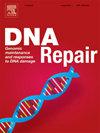PARP1在DNA双链断裂修复中的多重功能
IF 2.7
3区 生物学
Q2 GENETICS & HEREDITY
引用次数: 0
摘要
聚(adp -核糖)聚合酶1 (PARP1)是人类细胞中最丰富的核蛋白之一,在许多细胞过程中起着关键作用,包括对DNA损伤的反应。PARP1被单链和双链断裂激活并迅速定位,在那里它催化多链(adp核糖)链添加到自身和其他染色质或修复相关蛋白上。虽然PARP在单链断裂修复中的作用已经确立,但其在双链断裂(dsb)中的功能更为复杂,因为它可以促进或抑制dsb修复的多种途径中的各个步骤。在这篇综述中,我们研究了PARP1以及PARP2和PARP3对DSB修复的贡献,它们也在损伤时被激活。我们讨论了它们对断裂位点染色质调控的影响,它们在修复途径选择中的作用,以及修复机制的调控,包括同源重组、非同源末端连接和微同源介导的末端连接。鉴于PARP抑制剂在缺乏同源重组修复的癌症中的临床应用,了解这些不同的、有时相反的作用尤为重要。本文章由计算机程序翻译,如有差异,请以英文原文为准。
Multiple functions of PARP1 in the repair of DNA double strand breaks
Poly(ADP-ribose) polymerase 1 (PARP1) is one of the most abundant nuclear proteins in human cells and plays critical roles in numerous cellular processes, including the response to DNA damage. PARP1 is activated by and rapidly localizes to both single- and double-strand breaks, where it catalyzes the addition of poly(ADP-ribose) chains onto itself and other chromatin- or repair-associated proteins. While the role of PARP in single-strand break repair is established, its functions at double-strand breaks (DSBs) are more complex, as it can promote or inhibit various steps in the multiple pathways that repair DSBs. In this review, we examine the DSB repair contributions of PARP1, as well as those of PARP2 and PARP3, which are also activated upon damage. We discuss their influence on chromatin regulation at break sites, their role in repair pathway selection, and finally, the regulation of repair mechanisms, including homologous recombination, non-homologous end-joining, and microhomology-mediated end-joining. Understanding these diverse and sometimes opposing roles is especially important in light of the clinical use of PARP inhibitors in cancers deficient in homologous recombination repair.
求助全文
通过发布文献求助,成功后即可免费获取论文全文。
去求助
来源期刊

DNA Repair
生物-毒理学
CiteScore
7.60
自引率
5.30%
发文量
91
审稿时长
59 days
期刊介绍:
DNA Repair provides a forum for the comprehensive coverage of DNA repair and cellular responses to DNA damage. The journal publishes original observations on genetic, cellular, biochemical, structural and molecular aspects of DNA repair, mutagenesis, cell cycle regulation, apoptosis and other biological responses in cells exposed to genomic insult, as well as their relationship to human disease.
DNA Repair publishes full-length research articles, brief reports on research, and reviews. The journal welcomes articles describing databases, methods and new technologies supporting research on DNA repair and responses to DNA damage. Letters to the Editor, hot topics and classics in DNA repair, historical reflections, book reviews and meeting reports also will be considered for publication.
 求助内容:
求助内容: 应助结果提醒方式:
应助结果提醒方式:


